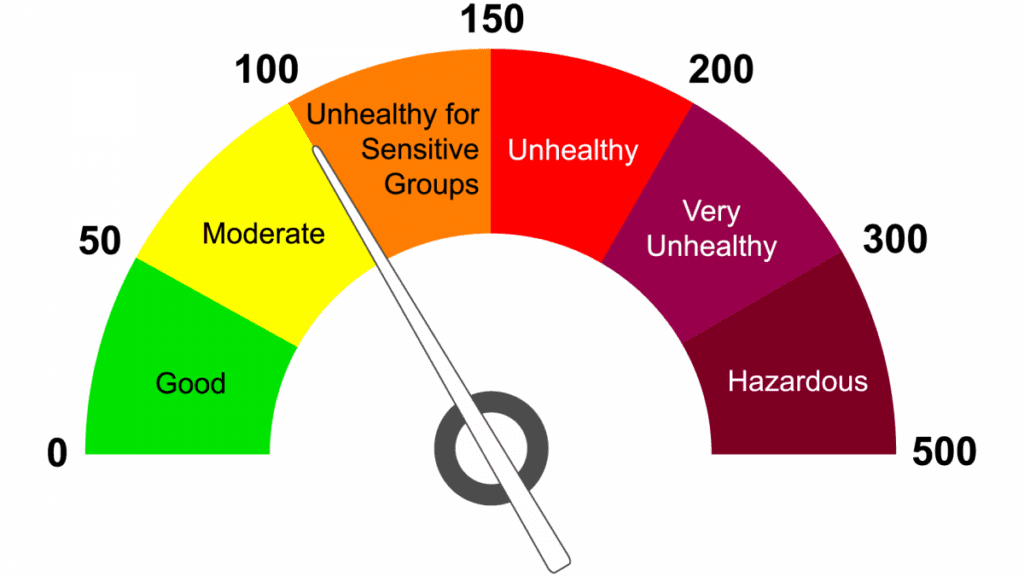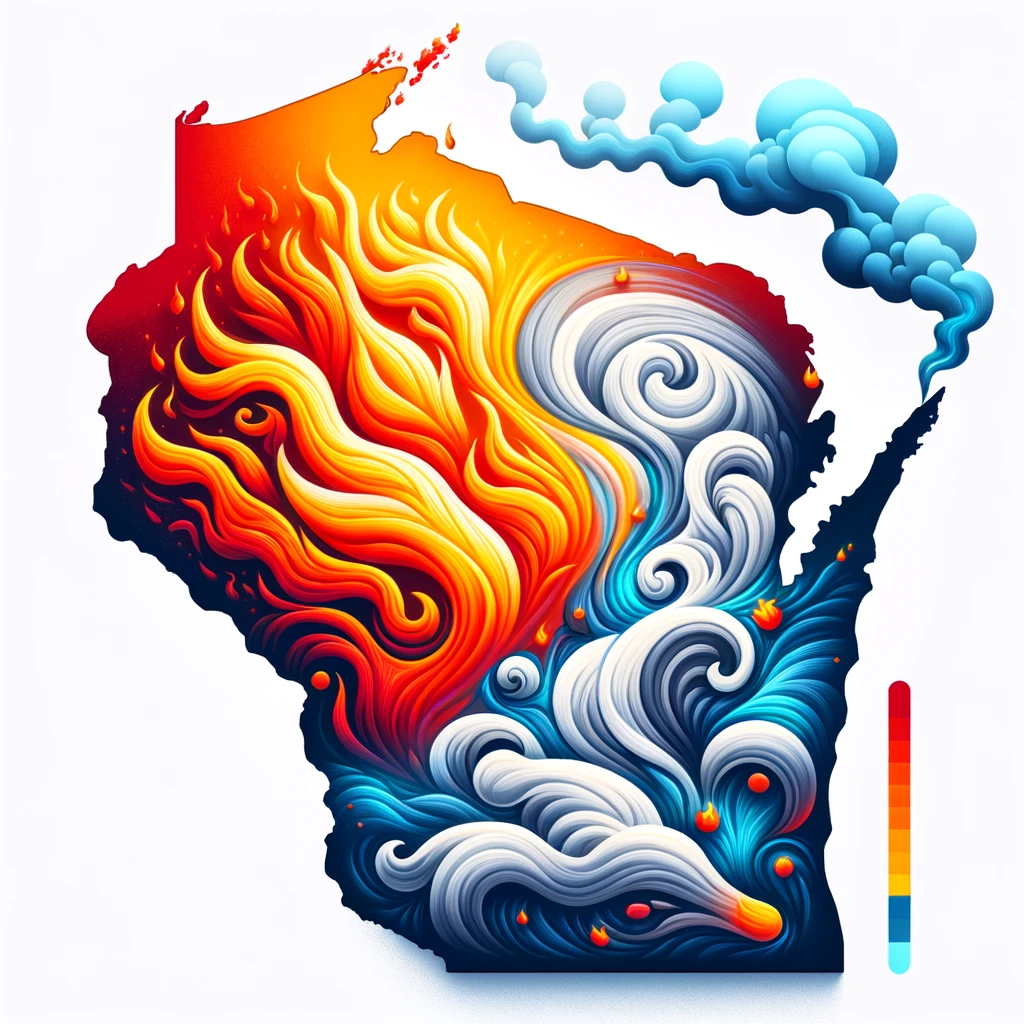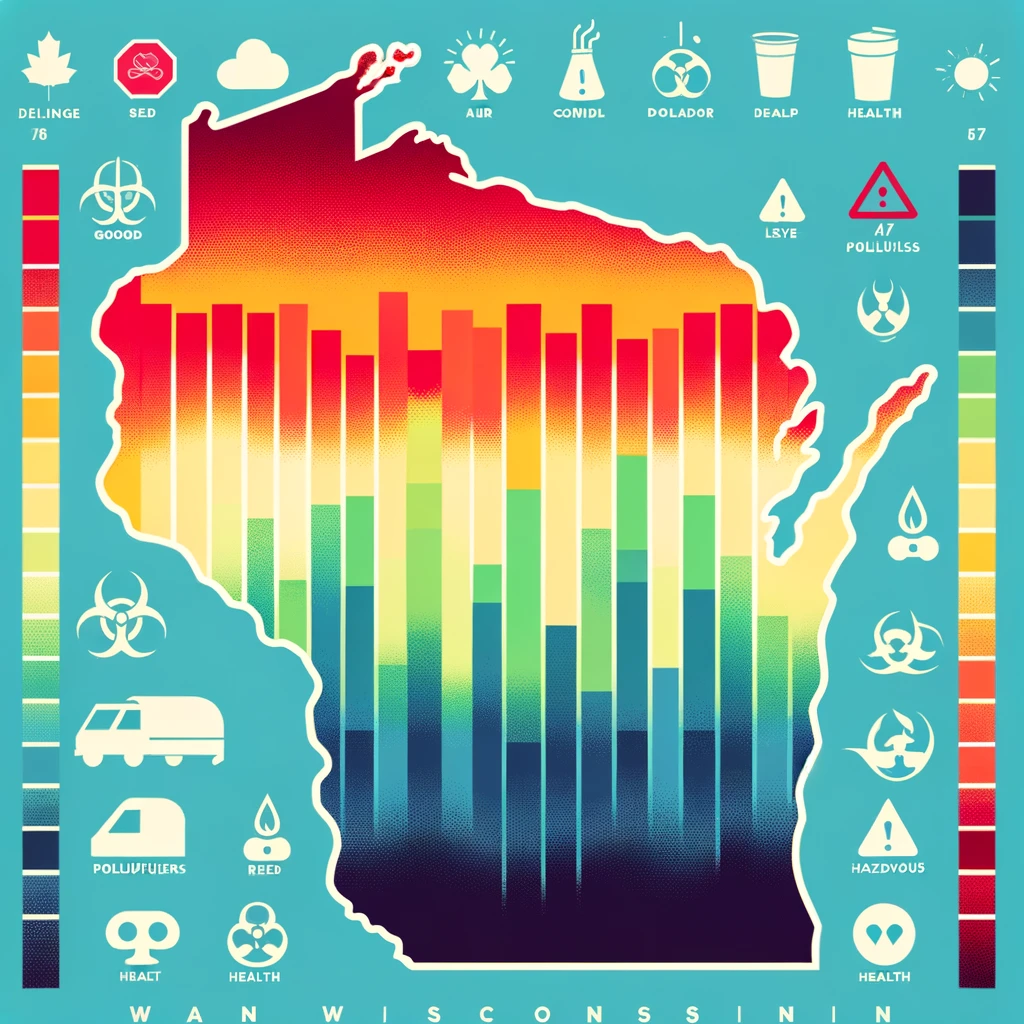Answered: How Bad Is The Air Quality In Wisconsin

Air quality is a growing concern for many, especially homeowners in Wisconsin looking to protect their health and families. From the haze in the sky to the difficulty some may find breathing, air pollution’s effects are far-reaching and deeply concerning.
One shocking reality is that Wisconsin ranks third worst in the country for air pollution, making it a critical issue for residents.
This article aims to illuminate the severity of Wisconsin’s air quality problem by examining factors such as the Air Quality Index (AQI), PM2.5 pollution, and current conditions affecting residents.
Armed with real-time data and expert advice, we’ll help you understand these issues and recommend steps to safeguard your health against poor air quality.
Key Takeaways
- Wisconsin ranks as the third worst state in the US for air pollution, with cities like Milwaukee/Racine/Waukesha facing high levels of PM2.5 and ozone pollutants that aggravate health problems.
- Factors such as wildfires and open burning significantly affect air quality by releasing smoke and harmful chemicals into the atmosphere, leading to respiratory issues and worsening health conditions.
- Wisconsin residents must monitor real-time air quality data through websites or mobile apps. This helps them stay informed about AQI levels and take necessary steps to protect their health.
- Implementing protective measures at home, such as using air purifiers, sealing windows on bad air days, and reducing outdoor exercise during high-pollution times, can help minimize exposure to poor air quality.
- Advocating for clean energy solutions and supporting policies to reduce industrial emissions is vital for improving Wisconsin’s air quality and safeguarding public health.

Understanding Air Quality in Wisconsin
Grasping the essence of air quality in Wisconsin requires a look at key indicators such as the Air Quality Index (AQI) and levels of PM2.5 air pollution. Various factors, from wildfires to vehicular emissions, play significant roles in shaping the state’s atmospheric conditions.
Air Quality Index (AQI) and PM2.5 air pollution
The Air Quality Index (AQI) is a tool for informing the public about daily air quality levels. It focuses on how clean or polluted the air is and what associated health effects might be of concern.
It considers various pollutants, including PM2.5—fine particulate matter small enough to invade even the smallest airways. PM2.5 pollution stems from sources like vehicle exhaust, wildfires, and industrial emissions, and it poses significant risks by aggravating respiratory and cardiovascular problems.
In Wisconsin, where the current air quality ranks among the worst in the nation, understanding AQI readings becomes crucial for homeowners looking to protect their families’ health.
Due to higher vehicular emissions and industrial activities, the state’s urban areas often experience elevated levels of PM2.5 pollution. This situation exacerbates existing conditions like asthma and heart disease while potentially causing new health problems in exposed populations.
Milwaukee/Racine/Waukesha’s rankings for particle pollution mirror this reality, which places them worryingly high on national lists for poor air quality environments.
Factors affecting air quality (wildfires, open burning)
Wildfires significantly degrade air quality by releasing vast amounts of smoke and pollutants, such as fine particle pollution, into the atmosphere. These particles reduce visibility, leading to hazy conditions. They also infiltrate deep into the lungs, triggering respiratory issues such as coughing and shortness of breath and aggravating existing heart and lung diseases.
Open burning of waste and agricultural materials further contributes to poor air quality by emitting harmful chemicals, including volatile organic compounds (VOCs) and nitrogen oxides.
Such practices not only pollute our environment but directly impact public health, exacerbating conditions linked to air pollution.
Monitoring and mitigating these sources is critical for maintaining clean air in Wisconsin. Clear regulations on open burning practices and enhanced wildfire management strategies can minimize their negative impact on air quality.

Current Air Quality in Wisconsin
Experts monitor Wisconsin’s air quality daily to provide real-time data on pollution levels. Homeowners can check the Air Quality Index (AQI) online to stay informed about smog and other pollutants in the air.
Real-time air quality data
Given Wisconsin’s significant concerns about air pollution, homeowners should monitor real-time air quality data. The table below presents an overview of the current air quality in Wisconsin, focusing on the Air Quality Index (AQI) and the primary pollutants impacting the state. This information is essential for protecting the health of Wisconsin residents and their families.
| Location | Current AQI | Main Pollutants | Health Implications |
|---|---|---|---|
| Milwaukee/Racine/Waukesha | Varies (50-150) | PM2.5, Ozone | Exacerbates respiratory and cardiovascular conditions |
| Northeast Wisconsin | Varies (60-160) | PM2.5 | Increases health risks, particularly for people of color |
| Statewide | Varies (Good to Hazardous) | PM2.5, Ozone, Nitrogen Dioxide | It can cause and worsen health problems, potentially deadly |
This table highlights the fluctuating nature of air quality across different locales within Wisconsin, with AQI values spanning from good to hazardous levels. PM2.5 and ozone are noted as the primary pollutants of concern. These pollutants can significantly worsen existing health issues and even lead to new health complications.
Given Wisconsin’s ranking as the third worst in the country for air pollution and the disproportionate exposure of people of color to harmful particulate matter, understanding real-time air quality data becomes a vital tool for residents. By staying informed, homeowners can take necessary precautions to protect themselves and their families from the adverse health effects of poor air quality.
AQI ranges and pollutants
Understanding the Air Quality Index (AQI) ranges and the pollutants that significantly impact Wisconsin’s environment is necessary. The AQI is a tool used to communicate how polluted the air is or is forecast to become. Public health risks increase as the AQI rises, and various pollutants are critical in determining these levels. Below is a detailed breakdown of the AQI ranges and common pollutants affecting Wisconsin’s air quality.
| AQI Range | Color Code | Health Implications | Common Pollutants |
|---|---|---|---|
| 0 – 50 | Green | Air quality is considered satisfactory, and air pollution poses little risk. | PM2.5, Ozone |
| 51 – 100 | Yellow | Air quality is acceptable; however, some pollutants may cause moderate health concerns for a very small number of people who are unusually sensitive to air pollution. | PM2.5, Ozone |
| 101 – 150 | Orange | Members of sensitive groups may experience health effects. The general public is not likely to be affected. | PM2.5, Ozone |
| 151 – 200 | Red | Everyone may begin to experience health effects; members of sensitive groups may experience more severe health effects. | PM2.5, Ozone |
| 201 – 300 | Purple | Health alert: everyone may experience more serious health effects. | PM2.5, Ozone |
| 301 – 500 | Maroon | Health warnings of emergency conditions. The entire population is more likely to be affected. | PM2.5, Ozone |
This table highlights the importance of staying informed about the AQI levels, especially considering the recent findings that Wisconsin’s air quality ranks among the worst in the nation, posing severe risks to public health. PM2.5 and ozone are the primary pollutants of concern, exacerbating respiratory and cardiovascular issues.
Awareness and understanding of these factors are essential for homeowners in Wisconsin to take proactive measures to protect their health and their families against air pollution.
Steps to protect yourself from poor air quality
After understanding the significance of AQI ranges and pollutants, it’s crucial to focus on how homeowners can safeguard themselves against poor air quality. Implementing protective measures becomes essential, especially considering the severe health risks associated with air pollution in Wisconsin.
- Check daily air quality reports: Use reliable websites or mobile apps to stay informed about the US AQI levels in your area. This knowledge helps you plan outdoor activities when air quality is better.
- Use air purifiers at home: Investing in high-quality air purifiers can significantly improve indoor air by filtering out harmful particulate matter and other pollutants.
- Seal windows and doors on lousy air days: Keep windows and doors closed on days with inferior air quality to prevent outdoor pollutants from entering your home.
- Limit outdoor exercise: Exercise increases your breath rate, leading to the inhalation of more pollutants. On days with unhealthy AQI levels, opt for indoor workouts.
- Grow indoor plants that improve air quality: Certain plants, like spider plants and peace lilies, act as natural air purifiers by absorbing toxins through their leaves.
- Avoid using wood-burning stoves or fireplaces: Burning wood releases particulate matter into your home environment, worsening indoor air quality.
- Install high-efficiency particulate air (HEPA) filters in heating, ventilation, and air conditioning (HVAC) systems: HEPA filters capture fine particles from the air circulating through your HVAC system, significantly reducing indoor pollution levels.
- Reduce volatile organic compound (VOC) emitting products: Household cleaning agents, paint, and personal care products can release VOCs that pollute indoor air. Opt for natural or low-VOC alternatives whenever possible.
- Advocate for clean energy solutions: Support policies and initiatives to reduce emissions from industrial sources and promote renewable energy options like solar or wind power.
- Stay hydrated: Drinking plenty of water helps your body naturally flush out toxins absorbed through polluted air.
Adopting these steps contributes to a healthier living environment. According to state-specific data indicating severe public health concerns, it combats the broader issues linked with poor air quality in Wisconsin, such as exacerbated respiratory diseases and cardiovascular problems caused by PM2.5 pollution.
Highlighting practices, everyone can implement signals a proactive approach towards protecting oneself from hazardous environmental conditions while underlining the urgency to address Wisconsin’s significant pollution challenges at both individual and community levels.
Conclusion
The air quality in Wisconsin has reached a critical point, with numerous factors like wildfires and coal usage dramatically impacting residents’ health. People across the state face increased risks of respiratory and cardiovascular issues due to poor air conditions.
Particularly alarming is the disproportionate impact on communities of color, who experience greater exposure to harmful pollutants. Real-time data shows fluctuating AQI levels, pushing the urgency for protective measures against pollution.
Everyone must heed guidelines and take personal steps to mitigate their exposure, emphasizing the profound need for statewide improvements in air quality management.
FAQs
What causes poor air quality in Wisconsin?
Several factors contribute to poor air quality in Wisconsin, including coal burning, vehicle emissions, and industrial pollution. Climate change also significantly contributes by increasing the frequency of air stagnation events and causing more severe wildfires in Canada. These fires can send smoke across borders, affecting local air conditions.
How does lousy air affect health?
Breathing polluted air can harm your health significantly. It can lead to problems with your chest, like asthma or bronchitis, and other serious health issues over time. Children and older adults are especially vulnerable to the effects of poor air quality.
What is being done to improve the air quality in Wisconsin?
Wisconsin follows guidelines set by the Clean Air Act of 1970, which aims to reduce pollution from various sources through regulations and standards for industries and vehicles. Efforts include monitoring pollution levels closely, promoting cleaner energy sources, and encouraging practices that reduce emissions.
Can rain improve the air quality?
Yes! Rain acts as a natural cleanser for the atmosphere. It helps settle dust particles and washes away pollutants suspended in the air, leading to temporary improvements in air quality after periods of rainfall or during times when an inversion layer traps pollution close to the ground.




